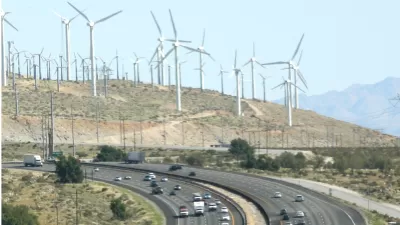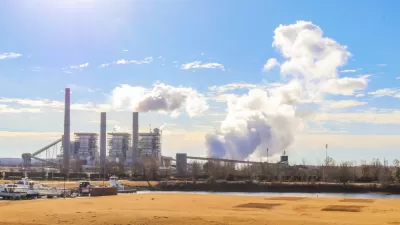The dramatic reductions in carbon emissions during the last year only highlight how drastically humans must change behavior to meet climate goals.

In the early months of the pandemic, the reduction in driving, carbon emissions, and traffic shone as one bright spot in the darkness of COVID-19. But the dramatic drop in greenhouse gas emissions brought on by pandemic closures won't last, writes Amina Khan in the Los Angeles Times, if governments don't take meaningful steps to maintain lower emissions and aggressively strive to hit their climate policy goals.
"To meet the Paris climate targets, the U.S. and the rest of the world will need to cut their emissions by about 1 billion to 2 billion metric tons per year — near-pandemic-level reductions — for every year throughout the 2020s." Yet "most current COVID-19 recovery plans are in direct contradiction with countries’ climate commitments."
One solution is to "ensure that post-pandemic growth is also tied to building a greener economy" and that new policies foster clean technologies as part of the economic recovery. The reduction in energy consumption during the pandemic was "deeply disruptive" to the lives of most people. But while Americans will largely go back to using the same energy-consuming devices and services they used before—and, in some cases, more of them as delivery services and digital tools become daily necessities—making those devices and services more energy-efficient can have similar and less disruptive benefits.
FULL STORY: COVID-19 helped slash 2020’s carbon dioxide emissions. How will we keep it going?

Trump Administration Could Effectively End Housing Voucher Program
Federal officials are eyeing major cuts to the Section 8 program that helps millions of low-income households pay rent.

Planetizen Federal Action Tracker
A weekly monitor of how Trump’s orders and actions are impacting planners and planning in America.

The 120 Year Old Tiny Home Villages That Sheltered San Francisco’s Earthquake Refugees
More than a century ago, San Francisco mobilized to house thousands of residents displaced by the 1906 earthquake. Could their strategy offer a model for the present?

Alabama School Forestry Initiative Brings Trees to Schoolyards
Trees can improve physical and mental health for students and commnity members.

NYC Outdoor Dining Could Get a Re-Do
The city council is considering making the al fresco dining program year-round to address cost concerns from small businesses.

HSR Reaches Key Settlement in Northern California City
The state’s high-speed rail authority reached an agreement with Millbrae, a key city on the train’s proposed route to San Francisco.
Urban Design for Planners 1: Software Tools
This six-course series explores essential urban design concepts using open source software and equips planners with the tools they need to participate fully in the urban design process.
Planning for Universal Design
Learn the tools for implementing Universal Design in planning regulations.
Ada County Highway District
Clanton & Associates, Inc.
Jessamine County Fiscal Court
Institute for Housing and Urban Development Studies (IHS)
City of Grandview
Harvard GSD Executive Education
Toledo-Lucas County Plan Commissions
Salt Lake City
NYU Wagner Graduate School of Public Service





























